Are you considering adding a new tiny friend to your household? A hamster or guinea pig makes great pets for first-timers and veterans alike. They’re adorable, they’re furry, and those liquid black eyes will just reel you in with their cuteness. That’s not even to mention the tiny whiskers and twitchy noses that’ll melt your heart.
Although they’re fairly similar at a glance, there are many contrasts that make hamsters and guinea pigs altogether different creatures (no, it’s not just their size). They have varying needs in terms of care and handling and distinct temperaments.
After reading this article, you’ll have a definitive answer to that burning question: are hamsters and guinea pigs the same? Let’s dive straight into the main differences and similarities between these infinitely lovable small pets.
Size
One of the most obvious differences between hamsters and guinea pigs is their size. While hamsters are significantly smaller than guinea pigs, both species can vary in size according to breed. For example, the American guinea pig’s size is smaller than the average standard guinea pig.
Hamsters have quite a large range, varying from two to fourteen inches long and 0.9 to 16.2 ounces. Guinea pigs aren’t as drastic, their breeds varying between eight to twelve inches long and weighing one and a half to two and a half pounds.
Diet
While hamsters and guinea pigs are both from the rodent family, their dietary requirements are quite different.
The hamster’s diet
You might be surprised to know that hamsters are omnivores. They eat plants happily, but they’re just as keen to chow down on meat. Typically, they need between one to two teaspoons of commercial food mix a day. Cucumber, carrots, unsalted shelled peanuts, and plain cooked chicken are delightful treats.
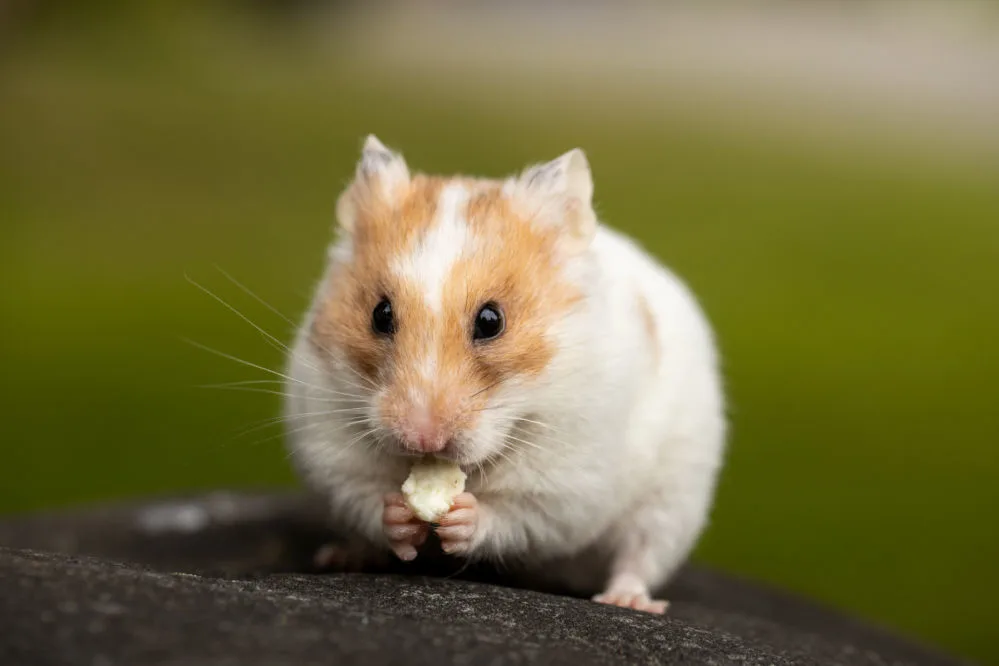
Hamsters are tidy eaters and will stuff all their food into their cheek pouches to take into their nest to store for snacking later.
The guinea pig’s diet
Unlike hamsters, guinea pigs are strictly herbivores. They require a large supply of fresh timothy hay (three or four fistfuls per day on average) and two tablespoons of commercial food mix daily. For fresh food, they love raw bell peppers, cucumber, leaf lettuce, carrots, and small slices of apple.
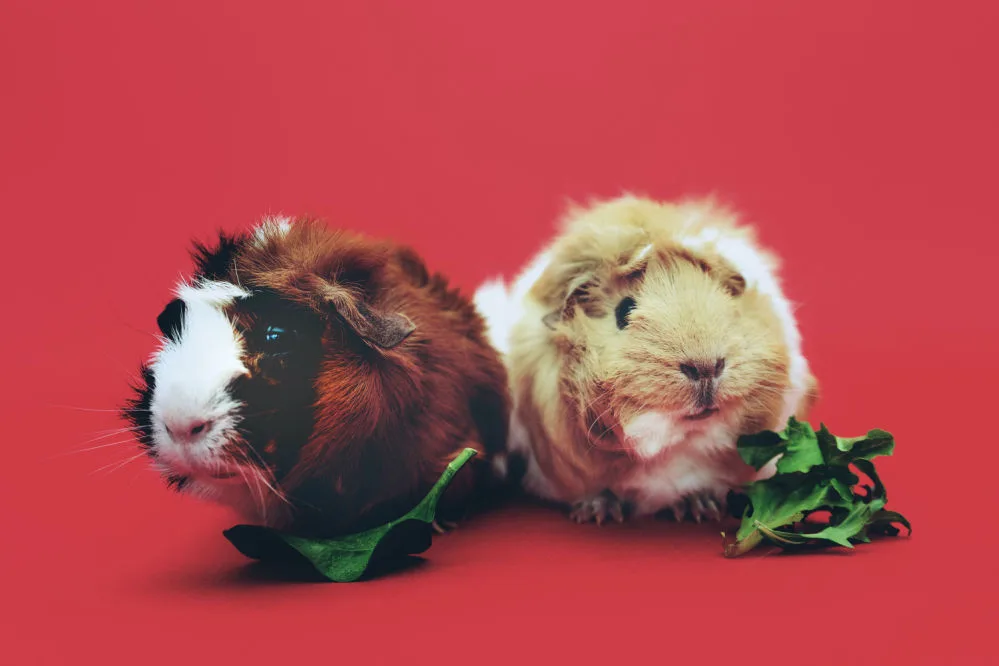
They’ll also need a daily vitamin C supplement if they don’t get enough fresh fruits and vegetables. Piggies are untidy eaters and tend to mess their food around the cage.
Different temperaments
These tiny but mighty family pets have very different personalities.
Hamsters
Hamsters sleep through the sunny hours and wake up at night for their nocturnal routines. They tend to be quieter than guinea pigs, but you may want to keep their cage away from your bedroom and invest in a quiet exercise wheel so they don’t mess with your sleep.
These are solitary animals, preferring their own company above all else. This fits with their strong territorial preferences — what’s theirs is theirs, and you better not mess with it. If they have a buddy hamster to live with, it would probably only cause strife with them fighting over who gets the best spot and who took the other’s food or toilet roll.
This isn’t to say they can’t tolerate someone else in their cage. You just need to be prepared for the possibility that they might need to be separated in the future if things turn sour. Hamsters are also skittish little things and will mostly run and hide if you try to interact with them.
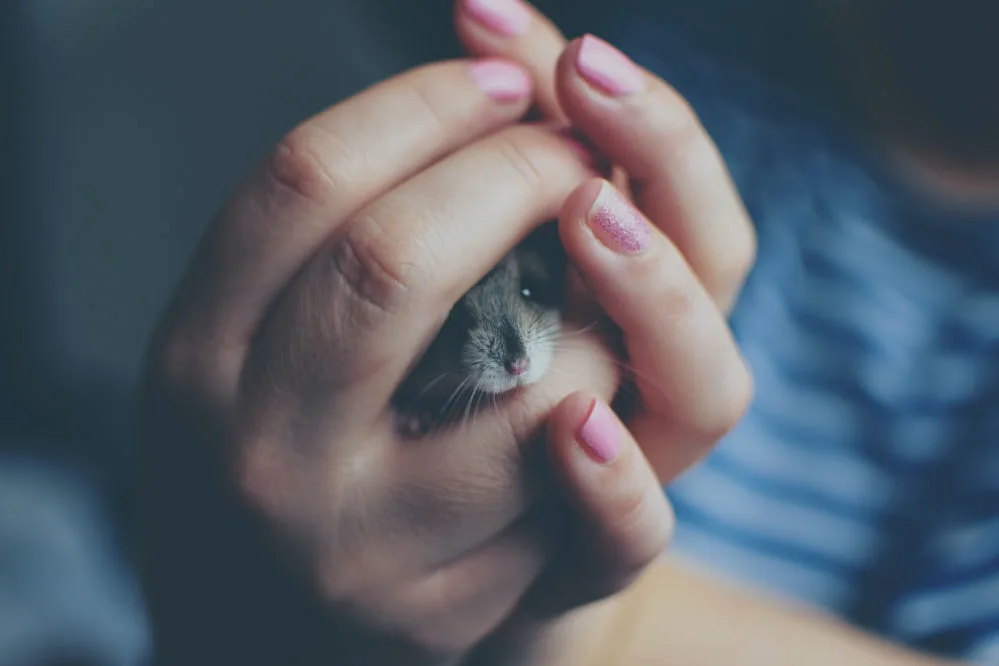
They also have no qualms with biting you if they feel at all threatened or if you don’t hold them correctly. There are exceptions to the rule, though. Some hamsters are so docile that they tolerate handling with ease and can even be cuddled to a degree.
Guinea pigs
Active during the day and heading for bed when the sun sets, these fluffy guinea pigs won’t interfere with your sleep cycle. But when they’re awake, they do tend to chatter away with their unique little squeaks.
These cute squeakers are herd animals, so guinea pigs are more social creatures and laid back than your average angry-mountain-hermit hamster. They do well in pairs and even groups because, as much as they enjoy spending time with you, the companionship of another piggy will upscale their happiness tremendously.
There’s just no substitute for that pig-to-pig relationship in their lives, so you’d best get them a friend if you want them to be their happiest selves.
Even within their own species, though, their personalities can differ. Some might be more adventurous and outgoing and come seek you out, while others may shy away and stay in their hut if they know you’re close by. Some will relax into your hands as you pick them up, and some will fight you to be put back on the ground.
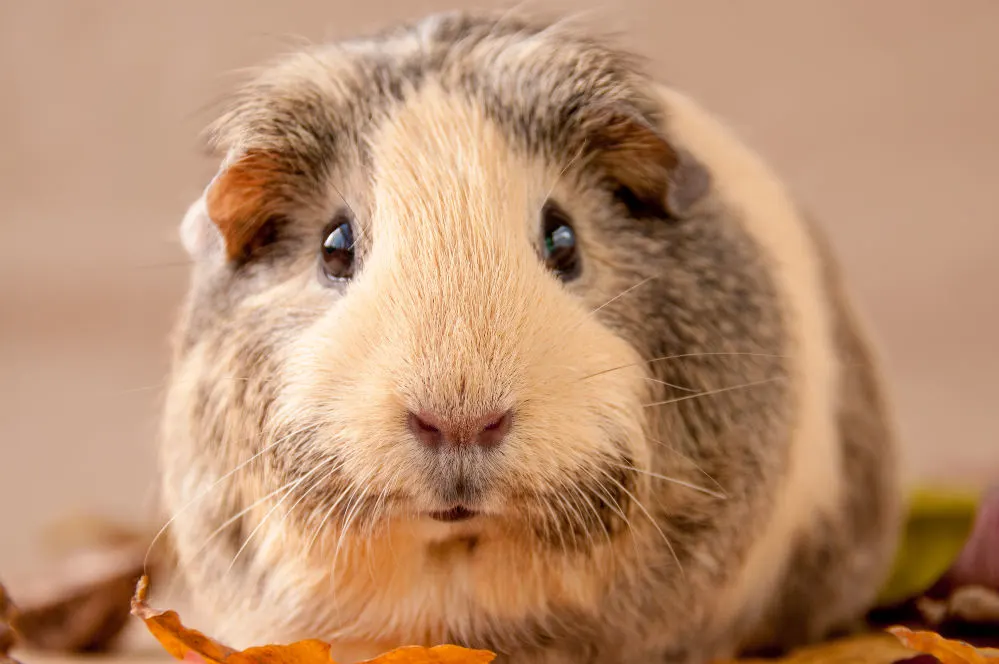
You’re probably wondering at this point: what are the odds of getting bitten if your piggy seems skittish and feisty? Guinea pigs are capable of biting, sure — but they very rarely bite, even if they’re the type to get stressed. They’re docile little creatures and will avoid getting toothy with you if at all possible.
Taming and socializing
It’s easy to think that these small furries won’t need as much attention and dedication as socializing a cat or dog. But nonetheless, they need the opportunity to learn to enjoy human interaction and become tame.
So how do you begin? Here’s all you need to know about taming and socializing your hamster or guinea pig.
Taming and socializing hamsters
They may be lone wolves, but these feisty little rodents can become accustomed to people once they’ve been tamed. We tend to fall in love with these cuties at first sight, but it takes them a bit longer to learn to like us back. At first, you’re just a stranger to them and, therefore, a possible threat in their eyes.
The best approach is to ease them into your presence: put their cage in a low-traffic area of the home and try not to disturb them while they sleep. Hamsters have negligible eyesight, so it’s your scent that they’ll come to recognize. You can help them get used to you by simply putting your hand in the cage without reaching for them, just so they can adjust to your smell and realize you won’t hurt them.

When your furry friend doesn’t run and hide every time you get close, you can try to entice them into your hand using a treat or two. At first, they may just come over, sniff your hand, and back off again. But continue this for two to three days, and eventually, the little guy will climb into your hand.
Once they get comfy there, pet them as much as they’ll tolerate and speak in a soothing voice to them. As they continue to relax in your presence and their new surroundings, they’ll want to start exploring everything, from items in their cage to climbing up and down your arms. Embrace the joy and let them have fun.
Taming and socializing guinea pigs
Guinea pigs are already friendly, social creatures that won’t need much encouragement to become your new furry best friend. They will still need time to adjust to you and your home, though, so don’t try to rush it.
Be gentle with them and try to avoid loud noises which might scare them, especially at first. The first step in establishing that bond is with food. Offer your guinea pig a treat and talk softly to them, but don’t try to reach out and touch them yet. The point here is to let them come to you.
Continue offering treats multiple times over several days. They’ll begin to associate you with food, which means they’ll come to you eagerly whenever they see you in hopes of a treat or two! Now that you’ve gained their trust, you can try petting your piggy.
Once they’re comfortable being petted, you can take the next step and pick them up. Hold them gently, though — they’re tiny, and any tight squeeze might make them distrust your handling. Once you’ve got the hold perfected, expect plenty of soft fuzzy cuddles and pets.
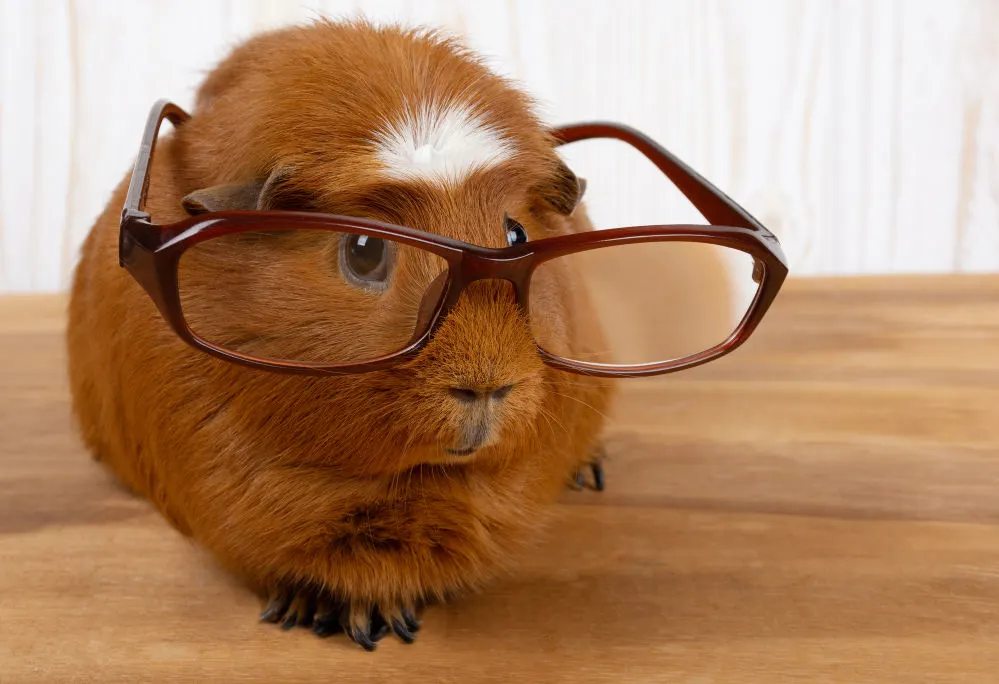
Exercise
Even if you’ve never owned a hamster in your life before, you’ll probably know what hamster wheels are. It’s one of those metaphors humans use all the time, but it’s a real necessity for your rodent buddy.
Hamsters need daily exercise and will, on average, run on their exercise wheel for three to four hours a night. Just make sure you choose a wheel that is solid rather than one with rungs to avoid their little feet getting caught and injured.
For extra fun, you can create a maze of tubes for them to run through in case you worry about the wheel becoming boring. You can get really creative and create a system that runs around the entire room, or keep it simple and just get one accessory that neatly sits by the cage.
Guinea pigs aren’t as athletic as hamsters, but they do still need some daily exercise to keep healthy. They thrive when they have three to four hours of free-range roaming a day, especially if their cage is on the smaller side.
Even if their cage is fairly big, though, it’s healthy for them to have some time outside of the cage for better mental stimulation, much like taking a dog for a walk outside of its garden.
Grooming
Hamsters don’t typically need to be groomed as they tend to keep themselves in tip-top shape. There are exceptions to this rule, though. For short-haired varieties, you can give their coat an extra bit of shine by lightly running your hands over them.
If you have long-haired females, they tend to get matted around their rears, so you might need to grab a fine comb and gently tease out the mats.
Guinea pigs, on the other hand, require brushing once a week to avoid matting if they have long hair, and they need their toenails trimmed every eight to twelve weeks. You may want to bathe them too, once every three to twelve months or so — it depends on how dirty they tend to get. But make sure you use a shampoo specific to small animals and not human shampoo.
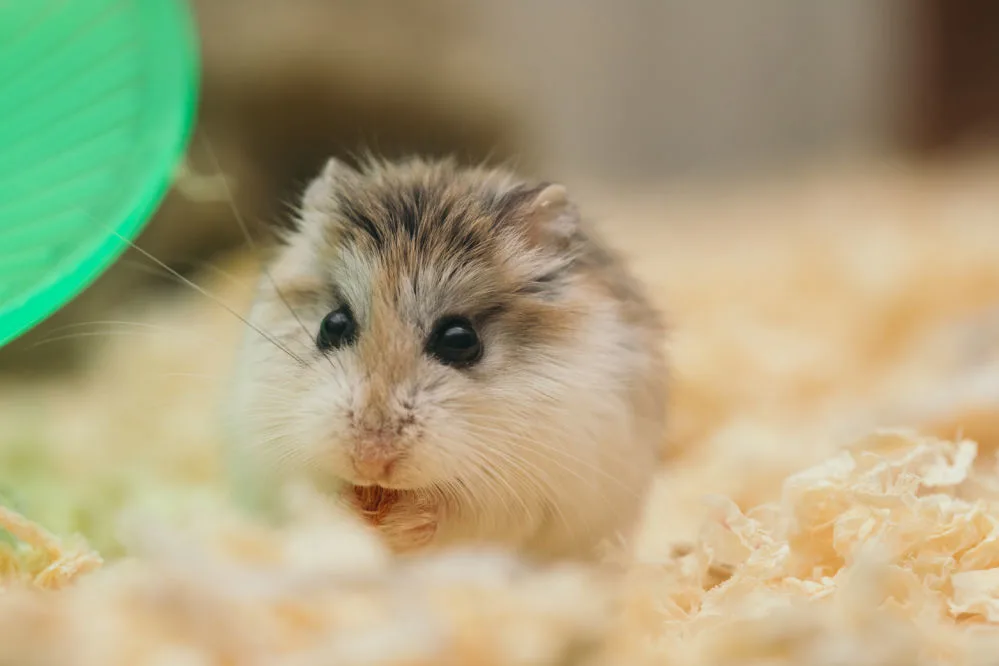
Cage requirements
For both species, having solid flooring and a wire mesh top is ideal for preventing any injuries to their feet and stopping them from chewing through their cage.
Hamster cage
They may need less space than guinea pigs, but hamsters ideally require a fairly large cage to run around usually around 2-3 square feet. You wouldn’t want to go smaller than 24 x 12 inches with a 12-inch height.
You’ll also want to make sure the bars aren’t more than half to three-quarters of an inch apart, or they might slip through (they are notorious escape artists). They’ll also need a nesting box, food dish, and water bowl.
Guinea pig cages
Guinea pigs need a lot more space. Seven square feet is the minimum for a single one. If you have two or more, you’ll need to add two to four feet of space per extra piggie. A height of 12-18 inches is perfect as they can’t jump. Guinea pigs can be housed indoors or outdoors, depending on your climate.
Bedding and toys
There are must-have cage accessories for both pets, and bedding and toys are two of the most important. They vary between the two species, though.
Bedding
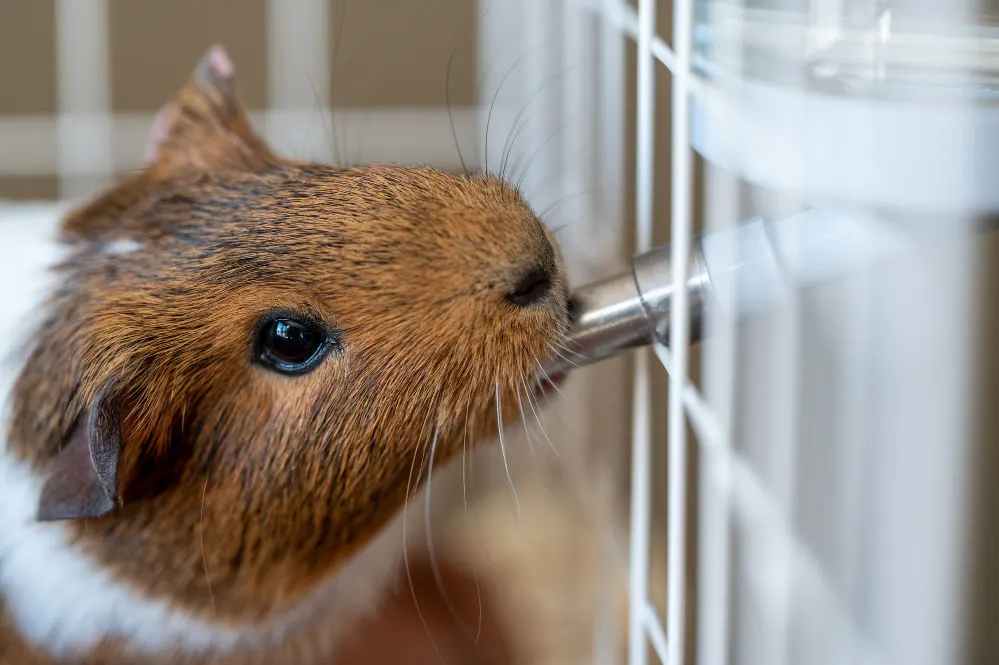
Hamsters love to burrow, so a deep bedding of recycled paper pellets and wood shavings (preferably aspen) is ideal. Avoid cedar or pine shavings as they contain phenols: aromatic oils which can make your pet sick. The bedding should be changed weekly.
Setting up a fleeced cage for a guinea pig is easy and one of the coziest for your pet as it’s soft and reusable. Natural paper bedding is also a popular option because it’s the most absorbent and offers the best odor control. You might need to refresh it midweek, but it should be washed or changed at least once a week.
Toys
Just like dogs needs a bone to chew and a ball to chase, your rodent pals need some toys to occupy their mental and physical energy. It helps enrich their lives and prevent boredom, ensuring they have a fulfilling day while you are busy elsewhere.
A hamster ball will enrich your hamster’s world, allowing them to be the master of its own destiny and letting them run wherever they want — within reason, of course.
Tip: This convenient set of toys has everything you could dream of to keep your little hamster busy, with all-natural wooden toys to climb, chew, and push around. There’s even a little hamster swing — how adorable can you get?
Guinea pigs don’t need the kind of exercise that hamsters do, so you don’t have to invest in a lot of toys and exercise equipment. Simply allow them space to roam. It may sound boring for them, but it’s good for their backs.
Playing with the types of toys hamsters play with can cause spinal issues for piggies. So if you want to enrich their roaming experience, let them out of their cage once in a while, or put them in a portable cage outside for a change of scenery with a collapsible tunnel.
They will, however, require a nice guinea pig chew to help them keep their ever-growing teeth at a comfortable length and pearly white.
Health concerns and diseases
Just like larger pets, guinea pigs and hamsters are prone to certain diseases and conditions that can fetch a vet bill that might make you blink twice. Regular medical check-ups will help prevent any nasty health issues from springing up and taking over your beloved pet.
Hamsters’ health issues
These tiny little warriors are prone to congestive heart failure, sometimes as early as six months old. It’s an expensive condition to manage, and there’s no cure, so tough decisions may be called for.
Hamsters also tend to suffer from diabetes; dwarf hamsters, in particular, are more likely to develop this. Teeth problems and abscesses are another concern if their oral health isn’t properly maintained. A common issue with aging hamsters is amyloidosis, a kidney disease; it also can’t be cured, but it can be managed with supportive treatment and is often linked with heart disease in older hamsters.
Guinea pigs’ health issues
Guinea pigs tend to develop pneumonia, usually arising from bacterial infection. They also have very sensitive gastrointestinal systems, so diarrhea isn’t uncommon.
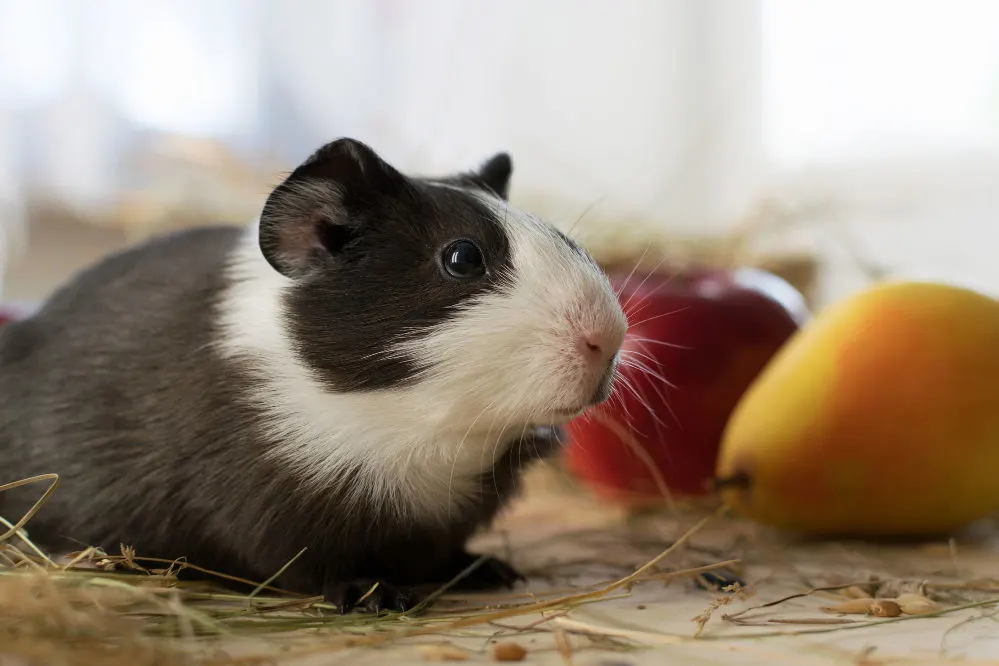
Due to the fact that they cannot manufacture their own vitamin C, they can also suffer from scurvy if they don’t get enough supplementation in their diet. Kidney and urinary stones are also very common with guinea pigs but can be diagnosed fairly easily by your vet.
Life span
Whenever you commit to bringing a pet into your life, one of the important things to consider is its lifespan. If losing a furry loved one is particularly hard on you, you might opt for a pet that has better longevity.
The life expectancy of hamsters is between one to three years, depending on the variety, so you don’t need to plan long-term for them. Guinea pigs, on the other hand, have a lifespan of four to eight years, so they’re a bigger commitment in terms of time and money on average.
Final thoughts on whether hamsters and guinea pigs are the same
As you can see, there are a vast number of differences between these furry cuties, even though they share some similar characteristics. The only thing to really consider at this point is which furry friend suits your lifestyle.
If a smaller animal that can be more easily contained is better for you, then a pet hamster is your best option. But if you want something you can cuddle and that will be awake during the day, the sweet chirping guinea pig is your ideal pet.
Interested to learn more about piggies? Read here about whether guinea pigs can eat apples, and how much apple is too much.
Steph Dyson is a travel journalist by trade but a lover of all small pets. She’s been a pet mum to everything from gerbils to guinea pigs, rabbits to hamsters, and fish to dogs of all shapes and sizes. She wants to share her years of experience with small pets and make Small Pet Guides the go-to website for pet owners seeking information and care advice.

